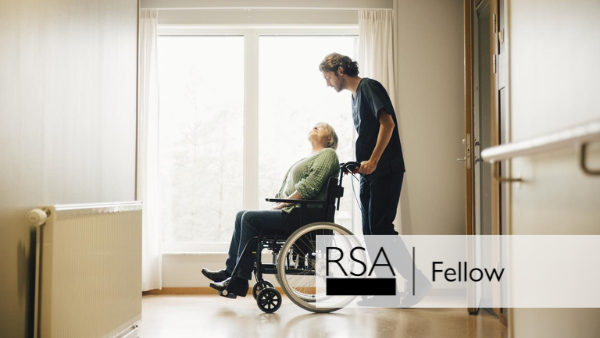FRSA David Marlow argues that the experience of Plymouth College of Art (PCA), a small university in Plymouth, is relevant to the impending task facing cities and regions; that of formulating a local industrial strategy in response to the government's November 2017 White Paper.
Over the last decade, Plymouth College of Art (PCA) has transitioned from small specialist further education college to a higher education institution with over 1400 undergraduates, and a post-graduate cohort. It has enabled a continuum of arts and design-focused provision in the city from the 1000 pupil four-16 year olds enrolled in the Plymouth School of Creative Arts (PSCA) to the 600-student 16-19 pre-degree campus at Palace Court. It hosts the city's FabLab, a range of studios and galleries and has been awarded a Social Enterprise Gold Mark. The college is currently establishing a ‘Cut, Make & Trim’ fashion manufacturing business community interest company in partnership with Millfields Trust.
PCA is projecting Plymouth's transition from traditional naval base and last major urban centre on the way to Lands End, to becoming a contemporary, innovative, and outward-looking city nationally and globally. The college is a founder member of the prestigious Tate Exchange and has been championed as being of national significance and international quality by Sir Nicholas Serota, Chair of Arts Council England (ACE). PCA leads and contributes to a number of European projects and is involved in Shanghai Wusong Art City one of the largest creative industry campuses in the world in a New City just outside Shanghai.
Without major changes in the way government and local leadership teams think about and act on universities’ relationships to place, the national industrial strategy and its local counterparts will inevitably stall in most places. The PCA offers four ‘anchors aweigh’ reflections that can stimulate different types of policy debate and action as the government's national approach is progressed into local industrial strategies
First, city leadership needs to do more than increase collaboration between the large heavyweight 'anchor' institutions of their economy - welcoming more disruptive, challenger institutions who are just as passionate about and committed to place as the incumbent leadership team into decision-making about future growth and development.
An implicit assumption underlying the industrial strategy is that local leaders (whether elected metro-mayors or local authority based) can get together with 'captains of industry' and a small number of larger anchors (major universities, NHS Trusts, perhaps others), to determine local strategic choices. These will be adopted after a credible, relatively light-touch consultation process, negotiated with government, and then delivery-managed by the leadership team with 'their' national and some local resources.
But how do incumbent leadership teams in cities and regions transcend the ‘usual suspects’ anchor institution dialogue to recognise important disruptive challengers and consider thoughtfully the scale-up and policy adaptation opportunities they present?
The PCA evolved largely at arms-length from mainstream city priorities: the failed 2017 City of Culture bid; the Mayflower400 2020 festival; and the 'Box' (History Centre) in the culture domain, let alone any broader based creative industries or learning strategy – and they are far from unique.
Of over 130 higher education institutions in England, around 40 have less than 5,000 students, and around 20 more are in the 5,000-1,0000 student range. Many of these smaller institutions provide strong focus in key areas of industrial strategy: creative industries, medicine, agriculture, business and industry itself. Leveraging the capabilities and agility of the 'PCAs' of our cities and regions may be as important in some local industrial strategies as increased anchor university collaboration. At the very least, these possibilities need to be recognised and considered.
Second, larger 'civic' universities should reflect on how their model(s) will adapt to be 'fit for purpose' for the challenges to 2020 and beyond. They are under increasing assault as remainer, elitist, out-of-touch, fat cats, with voracious appetites for real estate, housing and public finance, to attract student numbers, talent and research contracts. While there is no single model of either larger civic nor of smaller specialist higher education institutions, the question of how they refresh and reconnect with the places and communities where they have most impact is an urgent and important one. Can larger, more bureaucratic universities, weighed down by their anchor institution qualities learn something from the PCA story and that of other smaller, specialist higher education colleagues?
Third, local approaches to 'creativity' and 'making' should be as central to the local industrial strategies and education reforms as the current orthodoxies for innovation and skills. National and local public policy has an implicit focus on technology-led innovation enabled and supported by research-intensive universities, and STEM-based education, underpinned by stronger basic '3R' foundations. This provides the bedrock of Government’s prescription for the UKs future economic success.
The pedagogy and wider ethos underpinning PCA and PSCA majors on a creativity and making that enriches and grounds technology and STEM in personal growth and experience. Local industrial strategies must avoid a default to national prescription or curricula that, again, will inevitably support the needs and priorities of incumbent leaders. This is not an either/or binary choice. Rather it will involve welcoming the tension that deliberation on arts education and creative industrial models can provoke.
Finally, national and local policies towards higher education need to be recalibrated to provide some level of incentive for local radical reforms. University regulatory and funding systems remain overwhelmingly national. The Teaching Excellence Framework (TEF), Research Excellence Framework (REF), and the proposed Knowledge Exchange Framework (KEF) provide modest if any incentives for local relevance. Meanwhile, devolution deals and agreements give limited influence to local leadership teams in tailoring higher education policy and practise to local priorities.
The local industrial strategy 'system' is still subject to consultation (and some local choice) for major work areas of how it might play out. There are opportunities for smaller, specialist higher education institutions to contribute, for larger civic universities to embrace new ways of working locally, and for creativity and making to influence innovation and skills, perhaps driven by more ambitious, wider ranging local creative industries 'sector-deals'.
The Plymouth College of Art survived and flourished by pulling up its further education anchors in the noughties, charting a course based on exploring wide horizons of disruptive yet constructive transformation in our explicitly maritime city. We make no claims of replicability or universality for our story. But we do consider larger universities and city leadership teams that embrace an 'anchors aweigh' rallying cry will deliver better local industrial strategies with improved chances of success, as the UK tacks across the stormy seas of Brexit and beyond.
David Marlow is a FRSA and development economist. He runs Third Life Economics and is a Visiting Professor at CURDS, Newcastle University, working mainly on local growth strategies, devolution, leadership and organisation development.
Related articles
-
Stronger together: foundation building for third sector system working - part two
Mark Swift Ian Burbidge
In part two of the Comment article double bill, Mark Swift and Ian Burbidge explore how the VCSFE sector might align its efforts to liberate the best it has to offer.
-
Stronger together: foundation building for third sector system working - part one
Mark Swift Ian Burbidge
Learn how the diverse range of VCFSE organisations can collaborate effectively to harness resources, and strengths, and work with the complexity of social challenges.
-
The evolution and future of ‘pavement-led’ solutions
Richard James FRSA
Richard James has been using the Intensive Engagement process to engage local people in issues around community safety, revealing the hidden voices, assets and networks in local communities. He sets out his ambitions and some new challenges for the future.




Be the first to write a comment
Comments
Please login to post a comment or reply
Don't have an account? Click here to register.